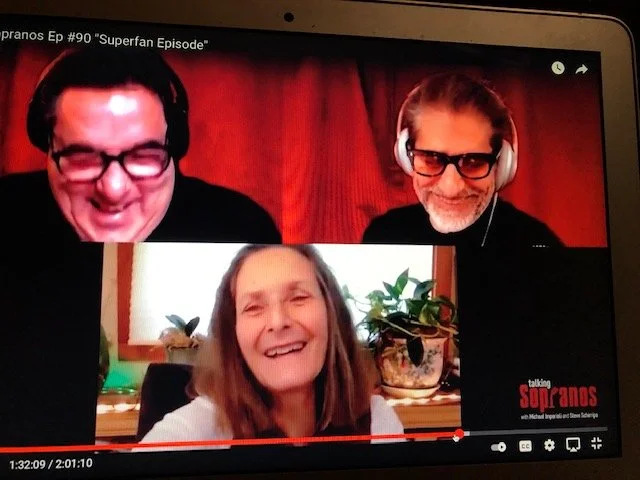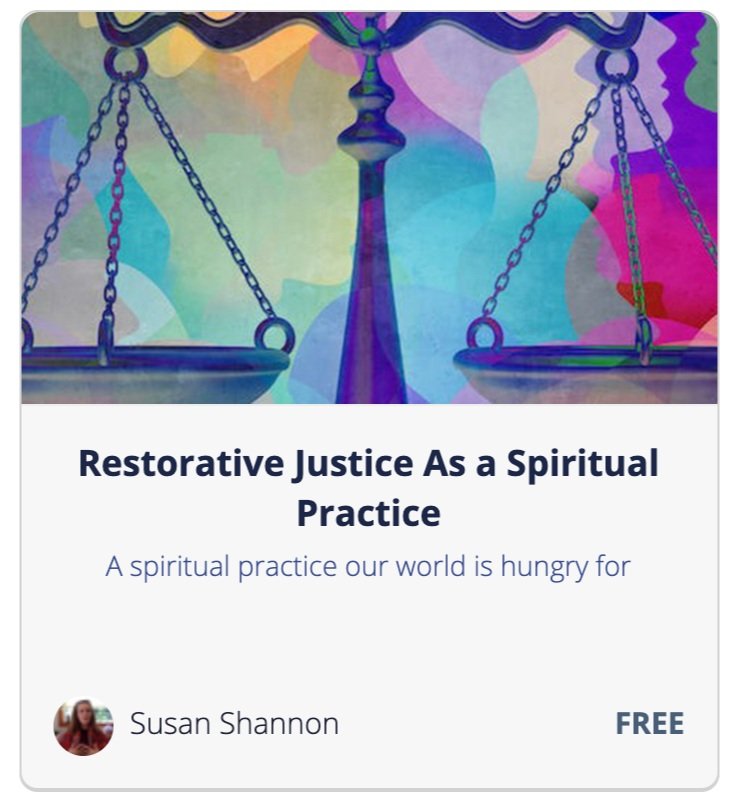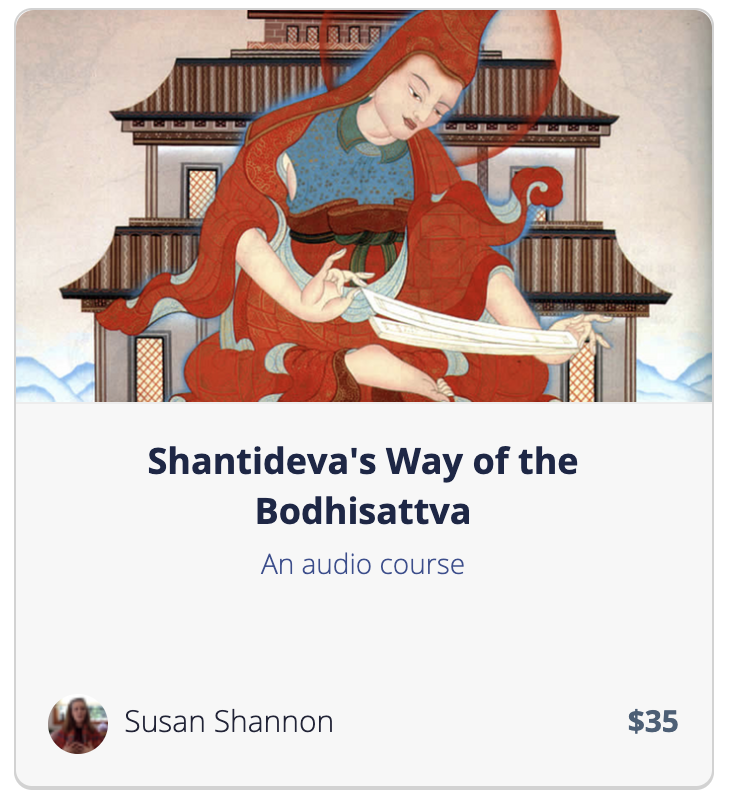The Dharma Meets The Sopranos
Susan Shannon, M. Div., BCC entered the Talking Sopranos Superfan Contest with her entry of 150 words or less that answered “Why are You a Sopranos Superfan and What Happened After the Cut to Black?” Susan was one of a handful selected to appear on the podcast. Her entry essay follows and you can watch her segment of the show below.
The Real Work Begins
I quit watching television when I was 14, after my first solo camping trip. As one friend told me ‘You are missing a lot of tape loops that most people have.’ And so it was. Fast forward to nearly 42 years later. My daughter had left me with a flat screen TV, and I had access to my housemate’s cable, but the TV had sat in a closet for years. One day my boyfriend hooked up the cable and voila, I was suddenly exposed to the epic shift between the era of Gilligan’s Island and Gomer Pyle to Dr. Phil, Oprah, gratuitous violence, nudity, drugs and a whole lot more.
I had just begun my prison work, attending the weekly Restorative Justice group in San Quentin State Prison, where outside volunteers would sit with inmates and talk about how to cultivate empathy, understand victim impact and other elements of Restorative Justice. Unlike a few of the other ‘self-help’ groups in the prison, inmate participants didn’t need to disclose the details of their crimes here. Over time, however, I was trained to facilitate groups where disclosure of their crimes was a fundamental part of the healing journey.
The very first day I attended one such group, a man stood up in the middle of a circle of inmates and tearfully, dramatically and in explicit detail shared the story of his commitment offense. In the fraction of seconds between “knife” and “35 times” I realized how easy these graphic images could lodge into my body. A little voice in my head said “Here you go. Now you get to see if you really are cut out for this work” but in tandem with that voice was as stronger, louder one that repeated “And this is suffering, and this is suffering, and this is suffering.” I pushed my feet into the ground and lowered my breathing, engaging the Mani mantra.
This was the moment my real work began.
Transformation is the Name of the Game
As a practicing Buddhist in the Tibetan tradition, transformation is the name of the game, so I was ‘all in’ with helping the men I worked with transform their violence and find peace. I read every book I could find on prison ministry, gang life, and the psychology of violence. I was driven to uncover all threads and echoes of judgement I might have about crimes and criminals, from the basic “how could such a nice guy have been driven to this heinous act of violence” as in a murder or burglary, to asking the same question of a crime of rape or worse. I knew my default response must be genuine compassion which meant spacious, empty, resonant compassion and a willingness to embrace the depth of suffering people held inside before they committed their crimes. This, all bolstered by constant energetic protection!
I began to watch The Sopranos, The Wire, and documentaries about Crips and Bloods. All helped me work the muscle of understanding, helped me let go of my conditioned response to the duality of good and bad. The hidden history behind the War on Drugs, the scaffolded, intentional creation of the crack cocaine epidemic, the endless oppression and secrets the men I worked with had been born into opened up. I was training in a new embodiment of Equanimity, one based on a rare and painful education in topics no one wants to know but so many cannot escape.
Within the Realm of Human Experience
I remembered something my lama years ago, upon learning that one of his monks had embezzled thousands of dollars from the non-profit I ran to help his monastic school. I fully expected him to be upset, maybe even to punish the monk. Instead, he softly spoke
“This behavior is in the realm of the human experience, so we must have compassion.”
I’ve leaned on this statement often when I needed help stabilizing my embodiment of equanimity, compassion, and a non-judgmental presence. Every single one of the many hundred crime stories I have heard had been ‘within the realms of human experience.’
Over the course of The Sopranos’ 86 episodes, the characters traverse the 12 Links of Existence in the Tibetan Wheel of Life. The whole show is an epic story of Dependent Origination, and the Four Noble Truths. The main characters of The Sopranos swim in the samsaric sinkhole of Hatred, Greed and Anger. Loyalty and betrayal are at the core of the show and most crimes - organized crime and street crime alike. If all inmates incarcerated for crimes related to these two words were freed, the prisons would be nearly empty.
“This behavior is in the realm of the human experience, so we must have compassion.”
The Sopranos became an ongoing teaching for me.
From The Sopranos to Prison Circles in San Quentin State Prison
I led several groups each week, groups comprised of opposing gang members, different races, creeds, colors and ages. I began each group with the silent aspiration that we could all be open to each other’s sufferings, to see the Truth of Suffering in its connection versus its isolation. This was our journey together. The stages of each program were carefully organized to provide gentle but consistent exercises to help the men feel safe and allow vulnerability to let their true light out. Over the weeks, the men’s initial resistance and guarded presence was replaced with fellowship and concern for each other.
My heart cracked open multiple times a day as these souls who had been hurt so deeply that they hurt others, broke down and copiously wept as they unburdened themselves from the stories and pain they had carried so very long. Many of them hadn’t cried for decades. “God’s Water on God’s Land” we would say. At the end of each session, we dedicated any healing we had experienced that day to all beings suffering in isolation, to our victims, to our family members, to all beings trapped in the jail cells of their closed hearts.
Understanding Victim Impact; the Restorative Justice Version of Tong-Len
All the Restorative Justice-based transformative work I’ve done with inmates (except Death Row where we did not talk about victims) included the element of Understanding Victim Impact. This includes identifying where in our life we were/are victims and understanding the causes and conditions that allowed our perpetrators to instill that harm on us. The Parole Board makes a strong distinction between causative factors and assigning blame. Causative factors are the truth of the matter. Blame is the narrative hurt people create about the matter.
The path to Understanding Victim Impact is not easy. One is led to identify and fully feel the depth of their pain and trauma, as only then one can emerge into the cultivation of compassion and understanding for whoever was involved in causing it. Learning that an abusive father suffered from PTSD is just one example that came up frequently, leading to a deepening of insight towards the possible door of forgiveness. So many people were raised to the saying “forgive and forget” so forgiveness was never an option. We were always clear that we forgive the person, not the act. Who doesn’t want to be forgiven for the worst decision they’ve ever made?
In Buddhist terms, we cultivate an understanding of the causes suffering of beings caught in samsara, based in the Four Noble Truths, and find compassion and understanding. This infuses our ability to see the Truth of Suffering in all beings, case in point, my challenge in hearing the first crime story. Is this not Tong-Len? Resonating with the suffering of others so that our compassion is boosted? Recognizing our interconnectedness is one of the fruits of Buddhist practice, and a foundational support for the philosophy of Restorative Justice.
As the Wheel Spins…
Tony, the main character on The Sopranos, and his crew did not let themselves feel or even talk about Victim Impact. An example is when both Big Pussy and Adriana were killed for betraying the Family by working with the FBI. The pain of killing someone you loved because that was how “the business” went, was buried with a toast and a steak, or acknowledged with a pat on the shoulder, but never extended beyond that.
Seeing this depicted over and over during the series was a great help to me. Nearly every inmate who was a former gang member participated in this “just business” aspect of ‘the game.’ Do a drive-by shooting then go to McDonalds and eat lunch. I really wanted to get my head around this mentality. I often heard about the gang practice of showing up at funerals of rival gang members so to kill even more. No thought of the grieving mothers and children - it was fish in a barrel. And yet here these men are now on their path of transformation going through the crucible of guilt, shame, remorse, tears, and commitment to never commit violence again. In our groups we analyzed many belief systems: male, female, gang, sports, military, etc, in order to discover how our minds are conditioned, limited, shaped and crafted to get the job done. The role transient, impermanent nature of identity and the dangers of becoming attached to that identity. Dharma Practice!
Another Round for Yama
As the Sopranos series closes, Tony gravitates back to the center of the wheel, and roosts in hatred, greed and anger. In the final, epic scene Tony kills his nephew Christopher. He has rescinded even further into his psychopathic tendencies, showing little to no feeling- and from there, he and the crew continue to spin the Wheel of Life, Yama holding everyone in his jaws, to be continued, next life - cut to black.
Susan’s short essay for the Talking Sopranos podcast:
I’ve watched seven full cycles of [The Sopranos] - and will likely do another round this winter. Gamed me up for my ten years of prison work with former gang members especially about the “just business” mentality.
As a practicing Tibetan Buddhist for nearly 50 years I see the show as exemplary of the *Wheel of Life which depicts Dependent Arising. The 3 poisons of Greed, Hatred, Delusion are central to the show. The series and characters travel through all the 12 Links of Existence:
1) Ignorance
2) Deluded action
3) Conditioned consciousness
4) Attachment to identity - name and form
5) Illusion of identity through the senses
6) Senses creating feelings
7) Feelings ruling attachment/aversion
8) Desire, craving
9) Attachment
10) Becoming - going round again
11) Birth - the chain continues
12) Old age and death
After the cut to black** Tony looked up and said “I think I’m changing my mind.”
*I deviated from some of the traditional description of the 12 links here
** ‘cut to black’ refers to the last scene in the series when the screen goes blank.










